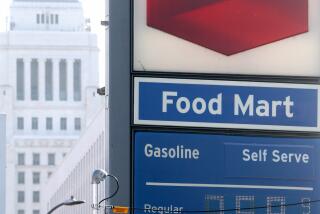100 Years of Cutting Along the Dotted Line
Americans live in a veritable blizzard of consumer coupons: 310 billion are printed each year.
But the coupon phenomenon is hardly new.
It started 100 years ago. That’s when pharmacist Asa Candler offered a coupon worth a free glass of Coca-Cola at his Atlanta soda fountain.
Coke and Grapenuts cereal are among numerous products that have hurtled into national prominence on the power of coupons, says Jan Leasure, a coupon author and columnist.
“Looking back a century, coupons have proved an enormously successful consumer promotion,” Leasure says. “The advantage of coupons is that they give products high visibility. A total of 6.2 billion coupons were redeemed in 1994, more than three times the number in 1974.”
More than 70% of Americans use coupons on a widening array of products and services that includes doctors’ visits, prescription drugs, even gravesites, she says.
Boston, Cincinnati, Detroit, Indianapolis, Philadelphia, Pittsburgh and Syracuse take the honors for greatest use of coupons, according to the Promotion Marketing Assn. of America Inc.
First Fulfillment & Management Co. of Easton, Md., designs coupons for manufacturers. It’s a major factor in the sweepstakes field. And it does a huge business mailing out premiums sought through mail-in rebate offers.
“We get so much mail in Easton that we have our own ZIP code, 21606,” says Tom Wright, president and chief executive of First Fulfillment.
Companies that use refund coupons are developing a huge data base of information on consumer preferences, Wright says. If you redeem a rebate offer for diapers, for instance, you’re likely to get mail for all sorts of baby products.
“The trend in couponing is to target individual consumers,” Wright says. “You don’t want to try to sell dog food to someone with a cat.”
Free-standing inserts, the colorful coupon booklets inserted in Sunday newspapers, have become so popular that many coupon hoarders now buy several such papers each week, says Lynn Liddle, a vice president at Valassis Communications, a Detroit-based coupon giant.
Manufacturers use coupons for different reasons--to advertise, change brand preferences or promote new products. Sometimes coupons for a new product, perhaps a cookie or cereal, will be targeted to just a few test cities.
“Couponing trends follow the trends of the United States,” Liddle says.
*
Coffee, for instance, is no longer in the top 10 categories of coupon use because of growing health concerns about caffeine. (Even so, consumers are redeeming an increasing number of coupons for flavored coffees.)
Overall coupon use has remained “pretty steady” during the last five years, says Barry Scher, a vice president for Giant Food Inc., the region’s largest supermarket firm. But Giant shoppers are using an increasing number of coupons generated by scanners at the checkout counter, Scher says.
Although used as early as 1895, coupons didn’t become a staple of everyday life until the Great Depression of the 1930s, when penny-pinching was a necessity for many.
Through much of their 100-year history, coupons were available only for packaged, canned, bottled or frozen edibles. Then there were coupons on health and beauty products. Fast-food purveyors got into the act in the mid-1980s.
More recently, coupons have appeared on over-the-counter drugs and new prescription products. They also have showed up for such professional services as visits to a lawyer’s office.
Of course, it’s not the retailers but the manufacturers who “pay back” consumers through coupons. Supermarket chains typically receive 7 cents to 10 cents per coupon as a “handling fee” for each coupon accepted, Leasure says.
Double coupons are a factor in competitive markets, but in the Washington area, where competition is less fierce, stores offer double-coupon deals far less frequently.
Consumers who use coupons save $4.8 billion each year, Liddle says, and those who pass them up “leave money on the table.”
Still, Leasure cautions consumers against using coupons for any purchase they might otherwise not make. “That would be a dangerous policy,” she says.
Leasure advises consumers to amass coupons only for products that they regularly use and to organize the coupons by aisles in the supermarket. And always use them with a sharp eye to comparison shopping, she says.
She calculates that coupons can save the average family of four $650 a year. That’s a payback of about $15 to $16 an hour for the time it takes to assemble and organize the coupons, she says.
In 1994, the face value of coupons rose to 63 cents, up 6% from the previous year, the trade group Promotion Marketing said. That’s ahead of inflation. But coupons expire faster than before, because manufacturers want faster feedback on product use for their databases.
The sources of coupons continue to multiply. Coupons generated electronically at the cash register are popular across the country, because they mirror consumer preferences. So are coupons distributed to shoppers (with or without food samples). Coupons also arrive in the mail.
In the information age, it was inevitable that the personal computer would get into the act. And sure enough, food-makers, including Healthy Choice, now have home pages on the World Wide Web where consumers can print their own coupons (subject to the same limits as other coupons).
San Diego’s Acu-Trac Services Inc., one of the five big players in the coupon processing field, is testing a system to let consumers trigger their own coupons when they watch TV commercials on cable. The viewer punches in a code on the remote control, and the coupon comes out of a small printer atop the TV, says John Taylor, the firm’s president.
Will electronic transmission of coupons one day play a major role?
*
Unlike Green Stamps, which reached their zenith around 1960 and proved short-lived, coupons “have become ingrained in the American way of life,” Liddle says.
Still, the total number of coupons in circulation could well diminish in coming years, says Mark Chesney, communications manager of NCH Promotional Services, a major coupon processing company based in Wilton, Conn. With careful pinpointing, manufacturers can have as big an effect with fewer coupons, he says.
Which sorts of coupons will prevail in the future?
“The market,” Chesney says, “will decide what works.”
More to Read
Inside the business of entertainment
The Wide Shot brings you news, analysis and insights on everything from streaming wars to production — and what it all means for the future.
You may occasionally receive promotional content from the Los Angeles Times.









